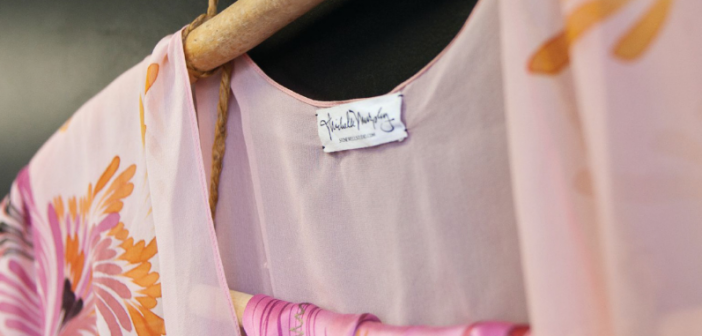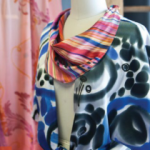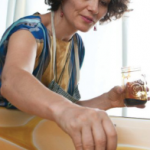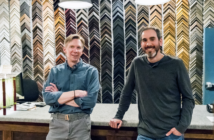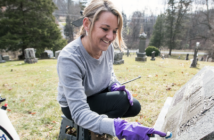Michelle Li Murphy and Norma Hildebrand Create Artistic Synergy Under One Studio Location
By Adam Kulikowski | Photography by Noel Kline
In a modest, 1,700-square-foot brick building on Pleasant Street in Hanover, a pair of artists tends to their trades.
They run their businesses independently—silk dresses and scarves beside handmade vintage baseball caps. Theirs are two worlds so far apart, yet not at all.
Michelle Li Murphy and Norma Hildebrand are a unique pairing. Hildebrand is an early riser, meticulous in her stitching and process as she creates vintage baseball caps for amateur teams throughout the country and other embroidery work. Murphy is a self-proclaimed night owl whose work style ebbs and flows with her hand-painted silk creations.
Hildebrand’s passion for creating vintage baseball lids began in the baseball Mecca—Cooperstown, N.Y.—decades ago selling hats out of her garage to fans of America’s pastime. She’s run her own business, transitioned to the corporate world, and returned to her craft.
Today, she creates her wares through Stockbridge Sewing Works in the Hanover studio she shares with Murphy. From pattern to sizing to adding the brim and team emblem, Hildebrand’s skilled hands gracefully guide each stitch to the smooth buzz of her sewing machine.
The pair has plans to work together on an upcoming wedding show to create custom gifts for bridesmaids and groomsmen. “We question one another when we reach an impasse on manufacturing or some type of problem; we try to help each other out,” Hildebrand says. “We collaborate on other projects as well.”
The creativity flows freely between the pair. “We’re makers,” Murphy adds. “Between the two of us and all of the machines, we can make just about anything. It’s a design studio here, really.”
Murphy cut her teeth growing up during summers as a street vendor in Key West, Fla., and later Seattle, Wash., with her father, Michael.
“My dad was also a maker. He made jewelry, belt buckles, shoes, hand bags, totes,” Michelle says. “Anything that was fabric related, he did a lot of painting on the surface—canvas to make little bags. He lived in Key West, so pockets on a string. And, he painted and stamped Key West, Fla. It was all handmade…That’s what we did when we spent time together during the summers. That developed my skill set.”
One of the items her dad sold was cotton painted ties. “They were not pretty!” Michelle laughs. But their style caught the eye of an executive at Mallory and Church, the second largest menswear company in the country at the time. They offered to fund her dad to develop a plan to create his paintings on silk ties.
Her dad moved to a remote area in Washington State near the Canadian boarder. With the help of a number of ‘hippy’ artists, Michael and Michelle developed the plan, from the dyes and the process, to the production replication and shipping.
The artists created ties of all sorts of patterns and styles—and learned how to replicate their work. “The clients were the Men’s Wearhouse, the Nordstroms. They expected consistency and that wasn’t the specialty of hippy!” Murphy says.
But, they were successful for nearly two decades. When their relationship with Mallory and Church concluded, Michelle and her father continued to prosper with their own business and storefront shop, Murphy Artisan Ties, selling neckties and scarves to more than 250 wholesale accounts.
Fast-forward to 2007. The business had continued to grow, but Michelle and her dad were now managing more orders than paint brushes. It wasn’t what Michelle wanted to do in life.
“Finally, one day at a show in Chicago,” Michelle says, “I was just like, ‘I want my dad back. I’m sick of this.’ I was making dresses a little bit. I was playing with the scraps…I’d stitch a ribbon on one corner and a stitch here or a safety pin there, and I would go out dancing. And people would ask me where I got it. They went for it. So, I started making them. I didn’t know how to sew, at least not technically. But I sure could make it hang off a girl’s body.”
So, she asked her dad to buy her share in the company. The tie business continued to flourish, and Michelle started to transition to developing dresses.
“I loved style,” Michelle says. “I loved interesting style. I love beauty. The nature of elegance [of fashion]just blows my mind. I wanted to wear flowers. I can’t control that passion in me…When women wear pretty things, they blossom themselves. They become so beautiful when they are confident and also with silk, it feels good too. Their skin responds. It makes you feel sexy.”
Then, everything crashed. Michelle lost her father to cancer, and her marriage fell apart while she was pregnant. It took her more than two years to recover, gather her bearings, and take the next step—as a fashion designer.
She took classes at the Fashion Institute of Technology in New York to learn pattern making and studied couture sewing techniques with Ella Pritsker of Ella Moda Designs in Baltimore.
Murphy removes a dress from the rack near her storefront window where she creates some of the most beautiful garments in the world. “This one you can see the stitching isn’t as refined,” she says. “The dress lays beautifully, but inside it isn’t as clean as it could be.”
Today, they are. Murphy begins each piece she creates with white silk, dyes, and a bamboo brush. Colors and designs are applied by hand, and then steam set and washed until the excess dye is removed. Out of the silk, Murphy’s creativity shines. She’s a true artist—an illustrator with a brilliant mind for bright colors, patterns, and shapes.
Murphy’s process to create a custom dress centers on the client’s interests—who you are as a person, what colors you look best in, special symbols you have in mind, what era you’re drawn to, and what will make you happy. Sometimes that’s an easy process—to discover the perfect design. Sometimes it isn’t.
She laughs, “I had one customer that I just couldn’t feel. I finally reached out to her and asked if I could come to her home, see the art she had displayed, get a better feel for her style.”
It’s that attention to detail, that level of connection she channels, that sets her apart in fashion and as an artist.
“I’m thinking about the person I’m creating the dress for throughout the entire process,” Michelle says. “I think about who I interpret her to be. Every person has a feeling, and I try to hold onto that as I paint so that the art used, the conduit will work, and I can interpret their desire and develop something that another human being thoughtfully and lovingly made for them to shine their brightest. That’s the dream.”
Stonewell Studio
Owner Michelle Li Murphy
www.stonewellstudio.com
200 Pleasant St., Suite 11
Hanover, PA
917-334-8190
Stockbridge Sewing Works
Owner Norma Hildebrand
stockbridgesewingworks.com
200 Pleasant St., Suite 11
Hanover, PA
717-521-6765

